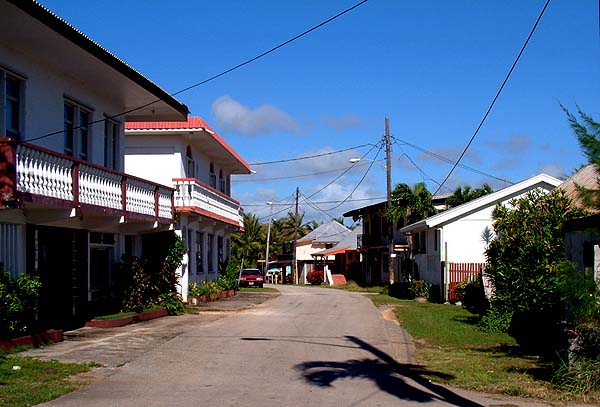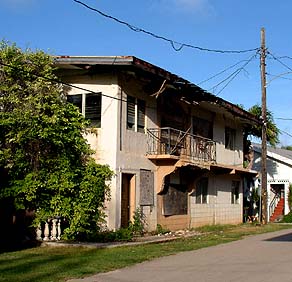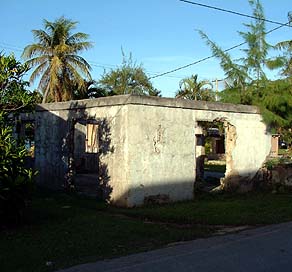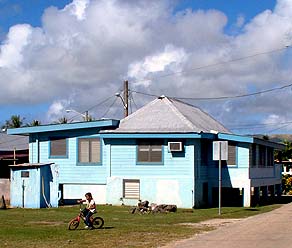 |
 |
 |
 |
||||
|
|
|
|
|
|
|
|
|
|
|
|||||||
|
|
|
|
Contrast of older and newer housing in the village.
|
|
|
“The village is marked as a historical village in itself,” Bill explains, “because of the Preservation Trust. Consequently, my mother-in-law’s house, for instance, is still standing and I remember we rehabilitated that house. But it was restored the way it should be, and so that it’s passed down. Unfortunately wood does not last here on island; the termites just deteriorate the wooden structures. "Why is this restoration important to the people of Inarajan? It is something we can say to the world: this is the way of our parents, that they have actually given us. We want to show to our children and our children’s children that this is something that is precious to them. It's not that we do not want any kind of development, but I believe that also development can cause a lot of things to change."
|
||
|
|
||
|
“I have a vision that I’m trying to share," Judy says, "based on how the village was when I grew up. It was a very busy village with a lot of things going on, and full of people who took care of each other. And now, as you walk down the street you see beautifully restored historic homes with, in between them, these eyesores of abandoned houses. "A lot of the families were given larger plots of land elsewhere in the area and they have moved out, and they haven’t managed to preserve what’s here. So my vision is to show people how this historic village can be restored. I don’t think we can go back to entirely the way it was, but we can preserve the essence of the way the village looked."
|
|
|
|
“As we’re sitting in this historic home [the Jose Cruz house], behind me there are two abandoned houses between here and Gef Pa’go, and I have said this and at least 2 or 3 other people have looked at those shells of houses and said, wouldn’t that be a great place for a coffee shop. You could build a deck, sit out and look over Gef Pa’go and look in to the ocean. “On the other side of this historic home is a two-story abandoned building that’s not only ugly, it’s unsafe. My vision is to work with the owners of these homes to help them understand the potential that these homes have, and if they don’t have the means to develop them, would they somehow work with us in a trust situation where we could find grants, and we could help develop them into something. For example, guest houses."
|
|
|
|
|
“The tourists now are more independent: they’re going on the web to find things, and they ‘re looking for culture. They like the hotels, but they want to go out on their own, and they want to experience the culture. And we have that potential down here. "So if we could get families to buy into the idea that these abandoned homes or underused properties could be developed into little guest houses that they could either run themselves, or we could be a kind of central booking agency and help them in this way, I think we could revitalize this village to be something that is really special for visitors as well as residents."
|
||
|
|
||
|
“And what I see happening after we start doing this is that people will start coming back into the village. They’ll see the potential. And if it’s not former residents, it’s going to be the young, educated Chamorro business people who come down and say ‘We can make something of this village, and we want to be a part of it.’ "I think this can happen, and its just taking these tiny steps in the beginning to put all the pieces together. It won’t be an exodus like it is now, but will start to be a place where we can build up."
|
Not much left of this one.
|
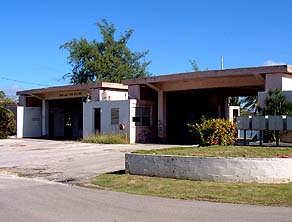
|
“And the main problem in this economy is people don’t have the money to develop their old houses. They’re busy paying for their new homes elsewhere, or renting apartments, and they just can’t extend their resources to include things like restoring a home or developing it within the the historic look that the village has, something that would fit into the village but could be used in a modern sense. "Why is the post office moved out of Inarajan? Why is the fire station up on the hill? Fire station okay, but post office? A little health clinic?"
|
|
“I’m thinking in modern terms but putting them in homes that are here, or in structures that are here, or places that have been abandoned but could be restored to fit that. A little bank. A little exercise gym. Boutiques, of course, and snack places, restaurants. "We’re already starting with that. We have someone that rents our kitchen here at Gef Pa’go, who sells malasadas, every morning. And they have a clientele of workers who pass by every morning and buy a dozen malasadas and take them to work. "So why don’t we expand that into people who would sell corn tortillas, which are not available anywhere else on the island, specialty foods, we could use our Chamorro oven to make cakes."
|
This home has been restored.
|
|
|
|
|
“There are just unlimited possibilities," Judy concludes, "and if we can get the mindset of the people to start thinking, we can do it."
Such efforts as Judy suggests would require the input and support of Inarajan's community.
|
||
|
|
||
|
|
|
|
|
|

|
| Inarajan Home | Map Library | Site Map | Pacific Worlds Home |
|
|
|
|
|
|
|
|||
| Copyright 2003 Pacific Worlds & Associates • Usage Policy • Webmaster |
|||
